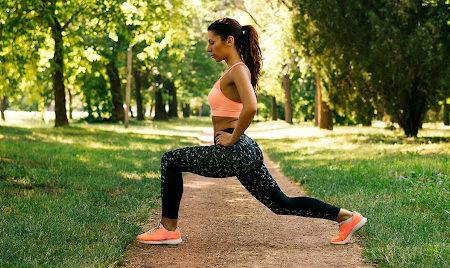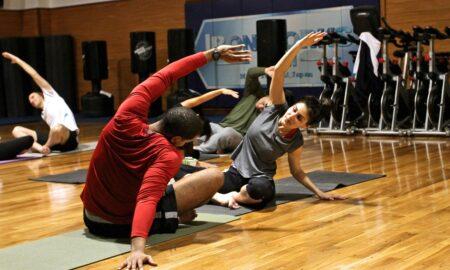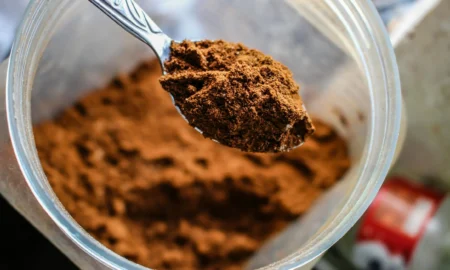The vast majority of males who start weight training do so for the same reason'to get bigger. It was certainly my motivation. When I graduated from high school and joined the Air Force, I weighed 135 pounds. Once I found a gym with weights and hit my growth spurt, things went fine, but the experience helped me understand the concern that young men have about gaining functional bodyweight. It's more than an egotistic whim; it's essential for self-esteem. Being a runt is no advantage in our culture. Being bigger is useful in every sport except gymnastics.
Mother Nature played a cruel joke on the male of the species. In his teens he desperately wants to grow and get stronger, but no matter how much he eats'and it's often a tremendous amount'he doesn't get any bigger. Later, when he has to limit bodyweight for health reasons, he can add pounds simply by looking at the restaurant dessert cart. Evidently, it wasn't a vital part of Mother Nature's plan for youngsters to become so involved in competitive sports.
The college-age male typically faces another problem in that regard: a lack of funds to buy the foods and supplements he needs to pack on muscular bodyweight. In most cases the food in the university cafeteria is high in calories and carbs, with little protein. So if a guy does gain bodyweight, it's often the undesirable kind.
Young men raising a family also cannot budget money to buy the much-heralded but costly supplements that help put on muscular bodyweight. When a person has three young children, laying out $30 for a can of whey protein, $35 for a can of creatine or $40 for a bottle of aminos is simply out of the question. I know because I was in that boat. When I worked for the YMCA, I'd save my change, and when I had enough I'd splurge and buy a can of Hoffman's protein powder. I always got the standard brand, which cost $1.50, and rationed it out over a couple of months. It contained such a low amount of useful protein that its benefits were most likely more mental than physical.
When I went to York to be interviewed for the position of assistant editor of Strength & Health, Tommy Suggs gave me a canister of Super Hi-Proteen, the top of the line. I'd only dreamed of having that level of protein powder; it cost five dollars. Back in Marion, Indiana, I called all my follow lifters, and we had a protein milk shake party. It was a grand occasion, for none of us had ever tasted the luxury product before. We were just like a group of gourmands at the finest French restaurant.
I think perhaps the best way for me to relate how to go about gaining useful bodyweight when money is tight is to tell the story of the athletes at the University of Hawaii in the early '70s. The ones who lived in Hale Anuenue, the athletic dorm, faced the problem of securing enough food to survive several times a year'and do so with very little money. That's because when there weren't any classes, the school cafeteria shut down. Those who couldn't afford a plane ticket to fly to the mainland had to purchase their own food at Thanksgiving, Christmas and semester and spring breaks.
Most, but not all, received some allowance from home, and their scholarships provided them with a meager amount for laundry, but money was tight'very tight. The breaks were perfect opportunities for them to train hard with the weights, since there were no classes or practices. They couldn't be expected to make any strength gains, however, unless they ate well. I'd just moved into the dorm when semester break came along and stranded two dozen football players. They came to me for advice. The first thing I did was find out how much money they had to spend. I calculated that they'd have to be able to eat on five dollars a day'no easy feat since Honolulu has never been a city known for buying food on the cheap.
With their problem in mind I visited a local food market, checked prices and came up with a plan. I told the three most affluent students'a relative term because none of them had much money'to buy a refrigerator, blender and hot plate at the used-appliance store near the campus. I'd gone there earlier and knew those items could be bought inexpensively. Later I bought a refrigerator for $20. I convinced them that they could easily get their money back by selling the appliances to other athletes when they left school.
Here's what I told them to purchase at the market: eggs, skim or whole milk, depending on taste, tuna, bread, a head of lettuce or sprouts, whichever was the cheapest, a box of powdered milk and salt. Optional items were ice cream or ice milk, honey, yogurt and pepper. I also sent them to a health foods store owned by Buster Nagao that was a short walk from the dorm.
Buster was a most generous patron of the football program. I wanted the athletes to buy honey and peanut butter from him for a couple of reasons. He'd sell the products to them wholesale, and I wanted the guys to have unprocessed peanut butter and honey. You might notice the absence of fruit on the list. Keith Gibson took care of that. I knew of a banana grove behind a state mental facility near Kaneohe. The bananas were never picked and generally went to waste'but no longer. We drove over the mountain and filled the back of his station wagon with the nutritious fruit. I contributed some pots, pans and a skillet that I'd purchased when I first moved to Oahu six months before, so they wouldn't have to spend any precious food money on those items. It was a communal affair. Those who were in better financial shape bought the optional foods and shared them with their more impoverished teammates.
Now they were in business. They hard-boiled the eggs at my suggestion. They ate the tuna straight from the can or made salads with it. Sometimes they combined hard-boiled eggs, tuna and lettuce for a great salad. They made banana, peanut butter and honey sandwiches and drank lots of protein milk shakes. Their diets were really quite complete. They took in plenty of high-quality protein and good fat in the milk, tuna, eggs and peanut butter. There were plenty of carbs in the milk, breads, bananas and honey. They were also getting a vast amount of vitamins and minerals. Some found that they couldn't digest the milk or yogurt and started making their shakes with fruit juice. They still added powdered milk and had no problem with that. (I believe many who think they're lactose intolerant are really allergic to the milk fat, not the lactose.)
At first those who were used to more variety and spicy foods grumbled about the monotonous diet, but not for long. It's amazing what genuine hunger does for a picky eater. Kids who'd turned up their noses at the idea of tuna salads and peanut butter-and-banana sandwiches were soon wolfing them down.
They reminded me of a story about two hunters. One told the other that he fed his dogs turnips only. The man replied, 'Why, my dogs would never eat turnips.' The first hunter said, 'Mine wouldn't either for the first 10 days.'
ALLThey all thrived on the Spartan diet. Occasionally, they'd substitute canned salmon for tuna if they found it on sale. I told them that if they wanted another inexpensive change to buy sardines. Sardines have a bit less protein than tuna but a great deal more calcium, phosphorus and potassium, and they were cheaper than tuna. Sardines became their snack food.
Those who wanted to add more bodyweight started drinking a protein shake after they trained and another at bedtime. They had an abundance of energy from the fats and carbs and were recovering from their workouts because of all the protein they were getting. A positive side of their dire economic situation was that they learned to be very selective when they went shopping. With only a few dollars in their pockets, they didn't bother looking at junk foods, colas, candy or pastries. Beer and pizza were also out of the question.
Since they couldn't afford to go out to nightclubs, they ended up getting plenty of rest. That was a plus for their lifting. They'd watch TV, listen to music, visit one another and play countless games of Pong in the dorm. They'd rigged the machine so they wouldn't have to pay and played far into the night. While it may not have been very exciting, it was a healthy lifestyle.
The leaner players started packing on more muscle, and the chubby ones, who didn't drink a milk shake at bedtime, began shedding unwanted pounds. That's because they were no longer stuffing themselves with the high-carb foods from the cafeteria or snacking on junk food at night. Now they were using their stored fat. They had more energy and were feeling much better about their new physiques. Even as they lost weight, they got stronger.
When school resumed, the athletes who'd been on the low-budget diet changed the way they ate at the cafeteria. They avoided the starches and loaded up on salads and foods high in protein. They continued to eat hard-boiled eggs and tuna and drank protein milk shakes at night. They liked the results they were getting from the extra protein.
That diet was the one that most of the top bodybuilders used before the miracle weight-gaining supplements burst on the market. They drank gallons of milk shakes, ate truckloads of tuna and raked in mountains of hard-boiled eggs. I traveled with Bill St. John to a contest in Virginia when he was at the peak of his competitive career. He carried a bag of hard-boiled eggs with him, and every so often I'd hear him cracking one. He ate them regularly to maintain a positive nitrogen balance, much in the manner of eating amino acid tablets. You can buy lots of eggs with what you'd spend on a bottle of aminos.
It wasn't uncommon for some bodybuilders to eat two dozen eggs a day. Whenever I tell a young man about the value of eating lots of eggs, he always comes back with the cholesterol problem. The cholesterol scare involving eggs seems to run in 20-year cycles. Currently, eggs aren't regarded as a cause of high cholesterol, which is good, because they aren't. The cholesterol in eggs is the kind the body needs to form hormones, including the sex hormones, create bile and feed brain function. Cholesterol is a vital part of cellular membranes.
Still, many argue that eating a large quantity of eggs will put too much cholesterol in the system and cause trouble. That doesn't happen because eggs also contain a built-in safeguard, lecithin, an emulsifying agent that literally moves excess cholesterol out of the body. Not only that, those who throw away the yolks are foolish. The yellow contains valuable nutrients: the B-vitamins in balance, A, D, plus essential minerals such as iron, selenium and hard-to-obtain sulfur.
There are, however, a few things you need to know about eggs to safeguard your health. Keep them in the refrigerator, and cook them thoroughly. The practice of throwing raw eggs in a blender that you saw in the movie 'Rocky' isn't a good idea. In fact, it's dangerous. In the '50s, Adelle Davis wrote in Let's Eat Right to Keep Fit that eating raw eggs was a health risk. If the eggs aren't cooked, a substance in them called avidin keeps an important B-vitamin, biotin, from reaching the bloodstream. A deficiency in biotin results in fatigue, drying of the skin and mental depression.
There's another, more critical reason to cook eggs: food poisoning. You may have read about outbreaks of serious illnesses caused by Salmonella enteritidis, a bacteria carried in chicken, pork, turkey, beef and egg yolks. The May '02 issue of National Geographic reported a 1994 incident in which trucks carrying the premix for Schwan's, a nationally distributed brand of ice cream, 'carried traces of raw eggs contaminated with Salmonella enteritidis. The outbreak sickened an estimated 224,000 people in 48 states.'
Scary? The good news is that when you cook the yolks thoroughly, the salmonella is destroyed, which makes hard-boiled eggs even more attractive. There's nothing complicated or messy about preparing them. Boil them for 20 minutes, let them cool, and then stick them in the fridge. Cook them at night, and you have a ready source of high-quality protein at your disposal. And they're still cheap. You can pay less than a dollar for a dozen jumbo size'a good quantity of nutrition for a buck.
If you decide to try this diet or part of it, it's important that you purchase the best. Even if funds are tight, don't buy low-grade tuna or peanut butter or white bread. Natural peanut butter is so much more nutritious than the processed kind, it is worth the few extra pennies. It also provides a good plant protein, with all the amino acids in balance, a variety of the B-vitamins and minerals used for cell rebuilding. The same goes for honey: Get the good stuff, and use a little less. Don't even consider white bread'it's nutritionally worthless.
The cornerstone of the gain-weight diet on a budget is the protein milk shake. I've been preaching the merits of making protein milk shakes from powdered milk for a long time. I first tried it when I was nearly broke and found that it worked just as well as the much more costly commercial protein powders. I do like some of the products on the market now and often buy them. But when I run out, I go back to the powdered milk. Sure, commercial protein powders and meal replacements are better, but powdered milk can work in a pinch.
Here's a tip on making a delicious milk shake. Don't put in so many ingredients that it resembles mud. While all the ingredients may be good for you, thick shakes get old in a hurry. Keep it smooth enough so that you can drink it down and not have to chew it. Here's the formula I like: a cup of powdered milk; eight ounces of whole or skim milk (skim milk has more protein per ounce than whole milk); a half cup of blueberry yogurt (it jacks up the taste, and the yogurt helps digestion); a scoop of strawberry ice cream or ice milk (ice milk has more protein than ice cream, but use what tastes best because you already have lots of protein). You end up with 50 grams of highly digestible protein.
Which brings me to my next point. It's been said numerous times but bears repeating: It's better to eat many small meals than a few large ones. Your digestive tract can assimilate only about 50 grams of protein at one time. If you overload, you pass off the excess, which means you're in effect wasting money.
Gaining functional bodyweight is more difficult than losing unwanted pounds, so be consistent with your eating and the milk shakes. Eat small amounts throughout the day, and drink a shake after training and another at bedtime. If you do that religiously, you'll get bigger, and if you're also training hard, you'll get stronger as well.
Editor's note: Bill Starr was a strength and conditioning coach at Johns Hopkins University from 1989 to 2000. He's the author of The Strongest Shall Survive and Defying Gravity. IM




















You must be logged in to post a comment Login